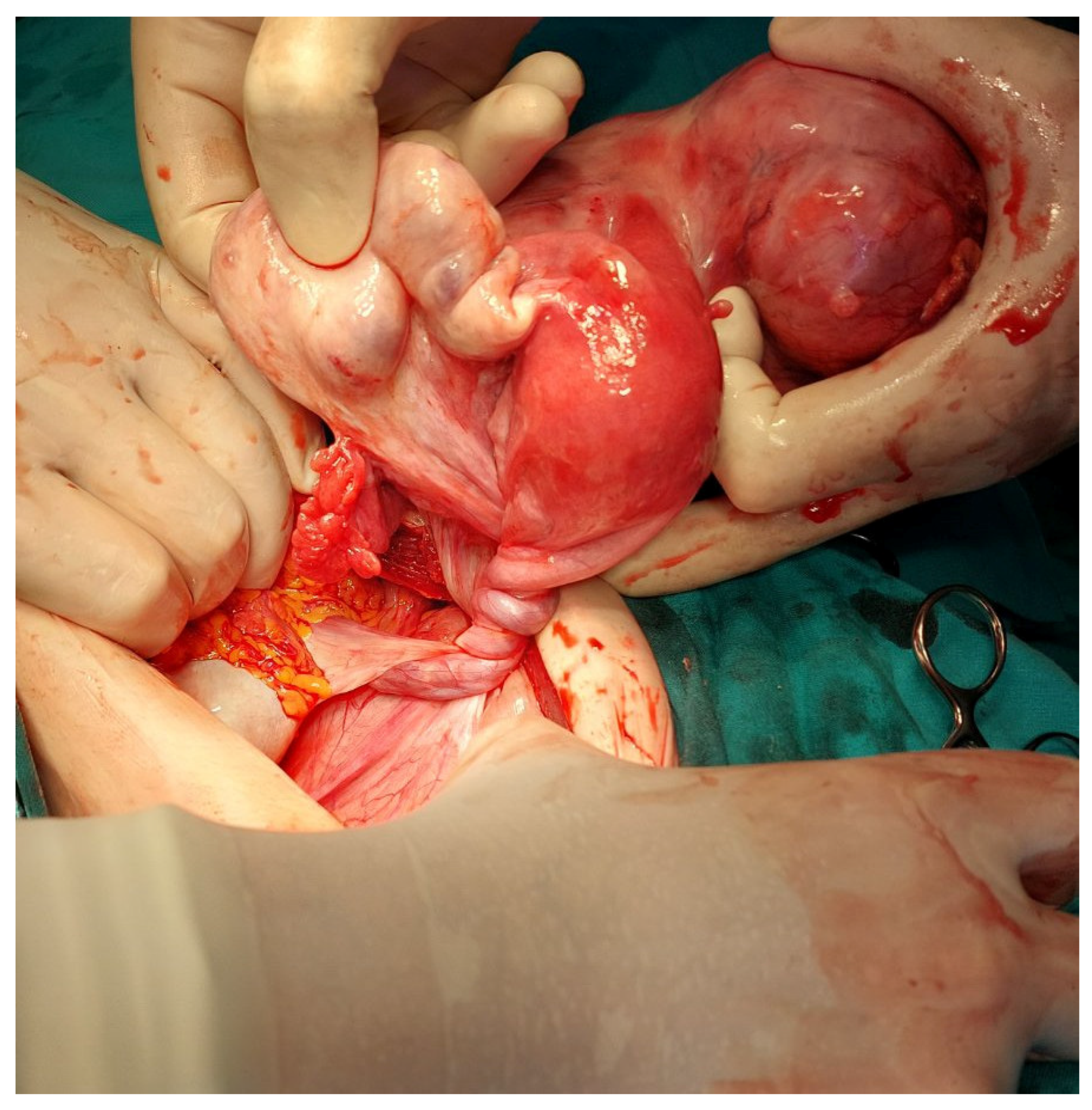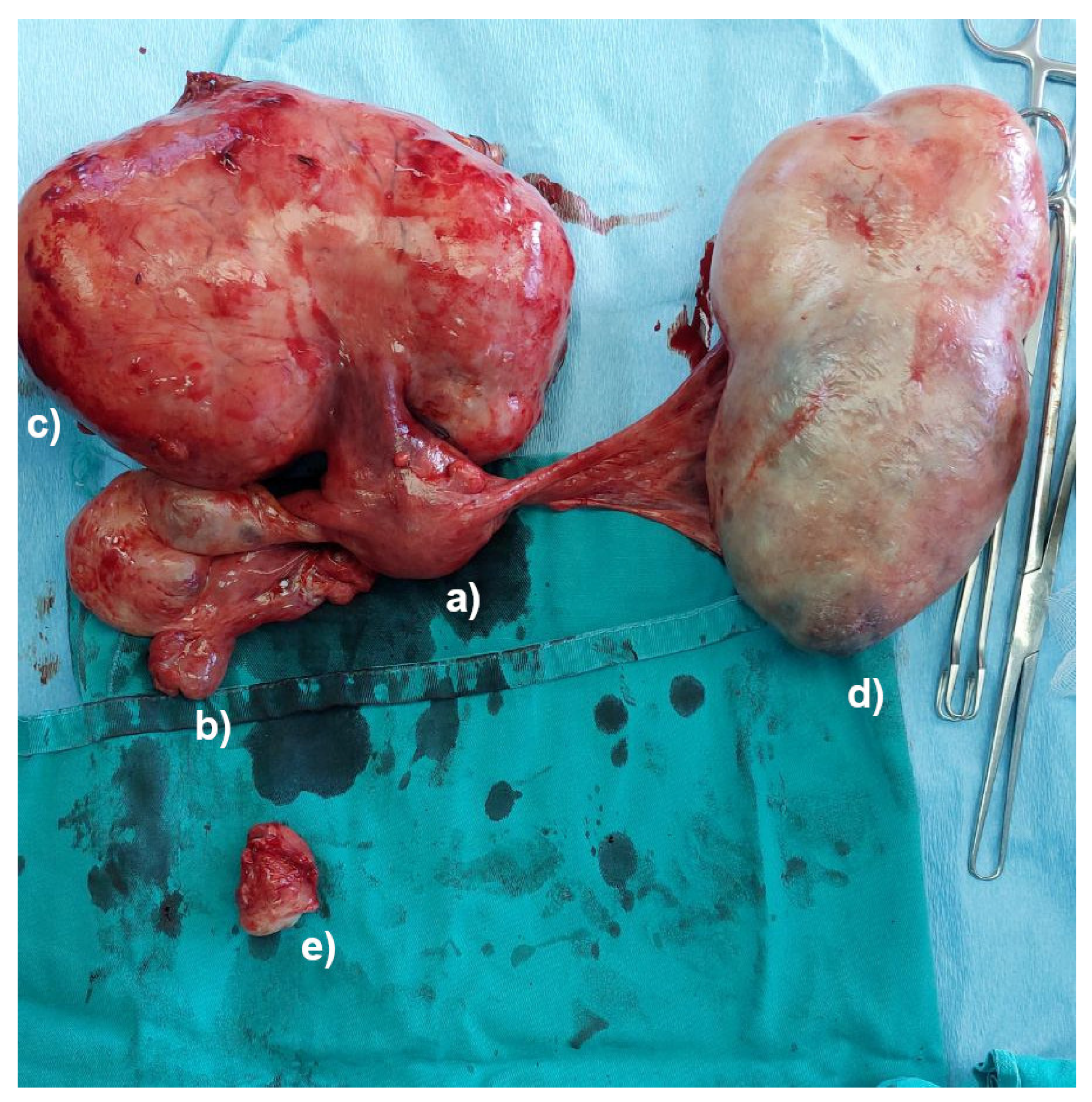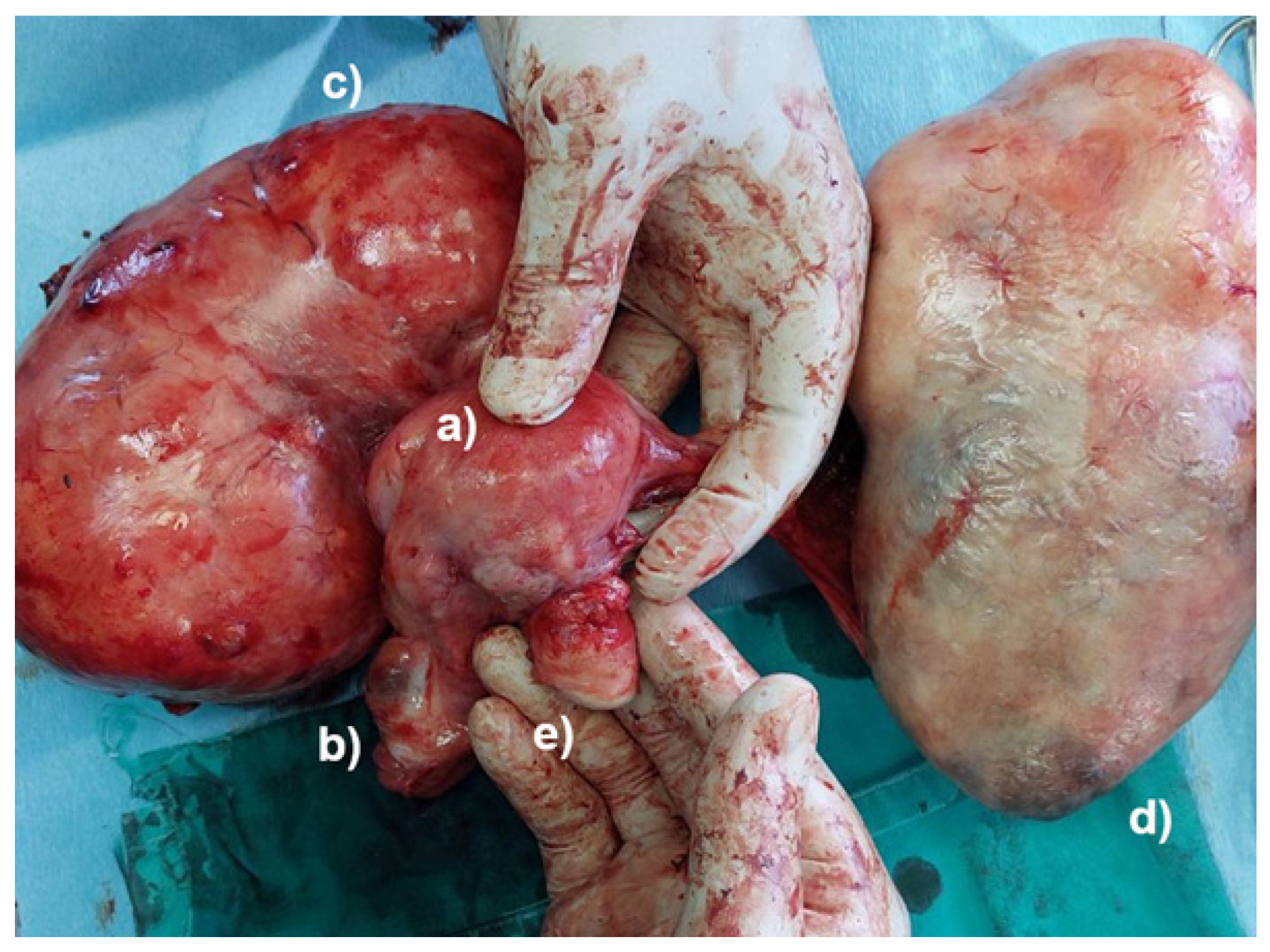Asymptomatic Cervical Amputation Caused by Uterine Torsion in a Non-Gravid Woman
Abstract
:1. Introduction
2. Case Presentation
3. Discussion
4. Conclusions
Author Contributions
Funding
Institutional Review Board Statement
Informed Consent Statement
Data Availability Statement
Acknowledgments
Conflicts of Interest
References
- Singh, S.; Tayade, S.; Patel, D. Torsion in Uterus: An Obstetrical and Gynaecological Emergency. Cureus 2024, 16, e54839. [Google Scholar] [CrossRef] [PubMed]
- Halassy, S.; Clarke, D. Twisting around an Axis: A Case Report of Uterine Torsion. Case Rep. Women’s Health 2020, 25, e00170. [Google Scholar] [CrossRef] [PubMed]
- Yuk, J.-S.; Yang, S.-W.; Lee, M.-H.; Kyung, M.-S. Incidence of Adnexal Torsion in the Republic of Korea: A Nationwide Serial Cross-Sectional Study (2009–2018). J. Pers. Med. 2021, 11, 743. [Google Scholar] [CrossRef] [PubMed]
- Hibbard, L.T. Adnexal Torsion. Am. J. Obstet. Gynecol. 1985, 152, 456–461. [Google Scholar] [CrossRef]
- Lai, Y.L.; Chen, Y.L.; Chen, C.-A.; Cheng, W.-F. Torsion of Pedunculated Subserous Uterine Leiomyoma: A Rare Complication of a Common Disease. Taiwan J. Obstet. Gynecol. 2018, 57, 300–303. [Google Scholar] [CrossRef]
- Havaldar, N.; Ashok, K. Torsion of Non-Gravid Uterus with Ovarian Cyst—An Extremely Rare Case. Pan Afr. Med. J. 2014, 18, 95. [Google Scholar] [CrossRef]
- Bui, T.T.K.; Le, T.V.; Nguyen, O.T.K.; Tran, H.T.B.; Nguyen, T.D.P. Uterine torsion in pregnancy: A case report. Int. J. Surg. Case Rep. 2024, 116, 109441. [Google Scholar] [CrossRef]
- Matsumoto, H.; Aoyagi, Y.; Morita, T.; Nasu, K. Uterine Torsion in Non-Gravid Women: A Case Report and Review of Cases Reported in the Last 20 Years. SAGE Open Med. Case Rep. 2021, 9, 2050313X2110666. [Google Scholar] [CrossRef]
- Collinet, P.; Narducci, F.; Stien, F. Torsion of non gravid uterus: An unexpected complication of an ovarian cyst. Eur. J. Obstet. Gynecol. Reprod. Biol. 2001, 98, 256–257. [Google Scholar] [CrossRef]
- Guié, P.; Adjobi, R.; N’guessan, E.; Anongba, S.; Kouakou, F.; Boua, N.; Dia, J.; Kouyaté, S.; Tegnan, J.A.; Djanhan, L.; et al. Uterine torsion with maternal death: Our experience and literature review. Clin. Exp. Obstet. Gynecol. 2005, 32, 245–246. [Google Scholar]
- Sikora-Szczęśniak, D.; Szczęśniak, G.; Łęgowik, T.; Sikora, W. Torsion of the uterus with myomas in a postmenopausal woman—Case study and review of the literature. Prz. Menopauzalny 2014, 13, 145–149. [Google Scholar] [CrossRef] [PubMed]
- Oda, H.; Yamada, Y.; Uehara, Y.; Ohno, T.; Hoya, M.; Sassa, M.; Mishima, M. Uterine torsion in an elderly woman associated with leiomyoma and continuously elevating muscle enzymes: A case study and review of literature. Case Rep. Obstet. Gynecol. 2020, 2020, 8857300. [Google Scholar] [CrossRef] [PubMed]
- Kilicci, C.; Sanverdi, I.; Bostanci, E.; Abide, C.Y.; Eser, S.K. Uterine Torsion of 720 Degrees in the Third Trimester of Pregnancy and Accompanying Bladder Torsion: A Case Report. Pan Afr. Med. J. 2018, 29, 175. [Google Scholar] [CrossRef] [PubMed]
- Jensen, J.G. Uterine Torsion in Pregnancy. Acta Obstet. Gynecol. Scand. 1992, 71, 260–265. [Google Scholar] [CrossRef]
- Yap, F.Y.; Radin, R.; Tchelepi, H. Torsion, infarction, and rupture of a nongravid uterus: A complication of a large ovarian cyst. Abdom. Radiol. 2016, 41, 2359–2363. [Google Scholar] [CrossRef]
- Nagose, V.B.; Rosemary, R.S.; Anandrajan, R.C.; Hubert, N.; Raj, R. Torsion of non-gravid uterus: A life-threatening condition in a postmenopausal lady. J. Obstet. Gynaecol. India 2020, 70, 393–396. [Google Scholar] [CrossRef]
- Chua, K.J.; Patel, R.; Eana, A.; Varughese, J. Uterine Torsion with Necrosis of Bilateral Adnexa in a Postmenopausal Woman. BMJ Case Rep. 2019, 12, e229311. [Google Scholar] [CrossRef]
- Wang, G.; Ishikawa, H.; Sato, A.; Shozu, M. Torsion of a Large Myomatous Uterus Associated with Progressive Renal Failure and Paralytic Ileus in an 86-Year-Old Woman. Case Rep. Obstet. Gynecol. 2019, 2019, 1601368. [Google Scholar] [CrossRef]
- Cheong, E.H.T.; Tan, T.J.; Wong, K.M. Torsion of a myomatous, non-gravid uterus: CT findings. J. Radiol. Case Rep. 2018, 12, 6–14. [Google Scholar] [CrossRef]
- Hashimoto, A.; Takahama, J.; Harada, N.; Maeda, S.; Anai, H.; Fukusumi, A.; Imai, S.; Kichikawa, K. A case of uterine torsion concurrent with a ruptured ovarian endometrial cyst. Abdom. Radiol. 2016, 41, 1707–1712. [Google Scholar] [CrossRef]
- Qin, J.; Wijangco, I.; Rashad, M.; Sugi, M.; Young, S. A Case Report of Uterine Torsion in a Postmenopausal Female with a Large Leiomyoma. J. Radiol. Case Rep. 2024, 18, 1–7. [Google Scholar] [CrossRef] [PubMed]
- Ye, Z.; Jiang, Y.; Yan, K.; Yu, C. Uterine Torsion with Degeneration and Infarction of Giant Leiomyoma in a Postmenopausal Woman: A Case Report. Medicine 2023, 102, e35964. [Google Scholar] [CrossRef] [PubMed]
- Norström, A.; Barlinn, A.J. Torsion of the Non-Pregnant Uterus as Diagnosed by X-Ray. Acta Obstet. Gynecol. Scand. 1987, 66, 573–574. [Google Scholar] [CrossRef] [PubMed]
- Luk, S.Y.; Leung, J.L.Y.; Cheung, M.L.; So, S.; Fung, S.H.; Cheng, S.C.S. Torsion of a Nongravid Myomatous Uterus: Radiological Features and Literature Review. Hong Kong Med. J. 2010, 16, 304–306. [Google Scholar] [PubMed]
- Matsumoto, H.; Ohta, T.; Nakahara, K.S.; Takanobu, K.; Hirohisa, K. Torsion of a Nongravid Uterus with a Large Ovarian Cyst: Usefulness of Contrast MR Image. Gynecol. Obstet. Investig. 2006, 63, 163–165. [Google Scholar] [CrossRef]
- Jeong, Y.Y.; Kang, H.K.; Park, J.G.; Choi, H.S. CT Features of Uterine Torsion. Eur. Radiol. 2003, 13, L249–L250. [Google Scholar] [CrossRef]
- Sachan, R.; Patel, M.L.; Sachan, P.; Arora, A. Complete Axial Torsion of Pregnant Uterus with Leiomyoma. Case Rep. 2014, 2014, bcr2014205558. [Google Scholar] [CrossRef]
- Liang, R.; Gandhi, J.; Rahmani, B.; Khan, S.A. Uterine torsion: A review with critical considerations for the obstetrician and gynecologist. Transl. Res. Anat. 2020, 21, 100084. [Google Scholar] [CrossRef]
- Omurtag, K.; Session, D.; Brahma, P.; Matlack, A.; Roberts, C. Horizontal uterine torsion in the setting of complete cervical and partial vaginal agenesis: A case report. Fertil. Steril. 2009, 91, 1957.e13–1957.e15. [Google Scholar] [CrossRef]
- Nicholson, W.K.; Coulson, C.C.; McCoy, M.C.; Semelka, R.C. Pelvic magnetic resonance imaging in the evaluation of uterine torsion. Obstet. Gynecol. 1995, 85, 888–890. [Google Scholar] [CrossRef]
- Davies, J.H. Case report: Torsion of a nongravidnonmyomatous uterus. Clin. Radiol. 1998, 53, 780–782. [Google Scholar] [CrossRef]



| Elements | Values | Reference Values |
|---|---|---|
| White blood cells | 13.3 × 109 L | 4.0–9.0 × 109 L |
| Hemoglobin | 103 g/L | 110–170 g/L |
| Hematocrit | 0.347 L/L | 0.360–0.470 L/L |
| C-reactive protein | 8.9 mg/L | 0.0–5.0 mg/L |
| LDH | 304 U/L | 220–450 U/L |
| CPK | 124 U/L | 24–170 U/L |
| Authors | Age | Symptoms | Torsion Degree (°) |
|---|---|---|---|
| Halassy et al. [2] | 70 | Abdominal pain | 180 |
| Havaldar et al. [6] | 55 | Abdominal pain | 180 |
| Matsumoto et al. [8] | 83 | Abdominal pain in lower abdomen | 90 |
| Sikora-Szczęśniak et al. [11] | 67 | Abdominal pain | 180 |
| Oda et al. [12] | 73 | Abdominal pain | 540 |
| Yap et al. [15] | 57 | Abdominal pain in lower abdomen | 180 |
| Nagose et al. [16] | 57 | Abdominal pain | 270 |
| Chua et al. [17] | 73 | Abdominal pain in lower abdomen | NA |
| Wang et al. [18] | 86 | Abdominal pain in lower abdomen | 360 |
| Cheong et al. [19] | 52 | Abdominal pain in lower abdomen | 720 |
| Hasimoto et al. [20] | 54 | Abdominal pain in lower abdomen | 180 |
| Qin et al. [21] | 83 | Abdominal pain, nausea, vomiting | 270 |
| Ye et al. [22] | 66 | Abdominal pain in lower abdomen | 540 |
| Norström et al. [23] | 68 | Abdominal pain, vaginal bleeding | NA |
| Luk Y et al. [24] | 61 | Abdominal pain in lower abdomen | 720 |
| Matsumoto et al. [25] | 73 | Abdominal pain in lower abdomen | 360 |
| Jeong et al. [26] | 87 | Abdominal pain, fever | 360 |
Disclaimer/Publisher’s Note: The statements, opinions and data contained in all publications are solely those of the individual author(s) and contributor(s) and not of MDPI and/or the editor(s). MDPI and/or the editor(s) disclaim responsibility for any injury to people or property resulting from any ideas, methods, instructions or products referred to in the content. |
© 2024 by the authors. Licensee MDPI, Basel, Switzerland. This article is an open access article distributed under the terms and conditions of the Creative Commons Attribution (CC BY) license (https://creativecommons.org/licenses/by/4.0/).
Share and Cite
Stefanović, M.; Vukomanović, P.; Kutlešić, R.; Trenkić, M.; Dimitrov, V.; Stefanović, A. Asymptomatic Cervical Amputation Caused by Uterine Torsion in a Non-Gravid Woman. J. Clin. Med. 2024, 13, 7356. https://doi.org/10.3390/jcm13237356
Stefanović M, Vukomanović P, Kutlešić R, Trenkić M, Dimitrov V, Stefanović A. Asymptomatic Cervical Amputation Caused by Uterine Torsion in a Non-Gravid Woman. Journal of Clinical Medicine. 2024; 13(23):7356. https://doi.org/10.3390/jcm13237356
Chicago/Turabian StyleStefanović, Milan, Predrag Vukomanović, Ranko Kutlešić, Milan Trenkić, Vanja Dimitrov, and Aleksa Stefanović. 2024. "Asymptomatic Cervical Amputation Caused by Uterine Torsion in a Non-Gravid Woman" Journal of Clinical Medicine 13, no. 23: 7356. https://doi.org/10.3390/jcm13237356
APA StyleStefanović, M., Vukomanović, P., Kutlešić, R., Trenkić, M., Dimitrov, V., & Stefanović, A. (2024). Asymptomatic Cervical Amputation Caused by Uterine Torsion in a Non-Gravid Woman. Journal of Clinical Medicine, 13(23), 7356. https://doi.org/10.3390/jcm13237356






